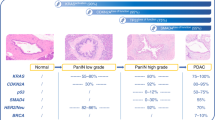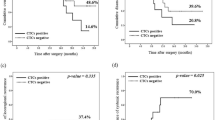Abstract
Background
Circulating tumor DNA (ctDNA) might be a promising biomarker for pancreatic cancer in liquid biopsy. This study aimed to evaluate the usefulness of liquid biopsy for patients with borderline-resectable pancreatic cancer (BR-PC).
Methods
Patients with BR-PC according to the National Comprehensive Cancer Network guidelines (2017) and eligible for neoadjuvant chemotherapy (NAC) followed by pancreatectomy were recruited at Wakayama Medical University Hospital (UMIN000026647) between March 2017 and April 2020. The study enrolled 55 patients with locally advanced PC, and each patient consented to inclusion in the study. The study investigated the relationship between KRAS status in ctDNA and clinicopathologic features, analyzing ctDNA at three time points: pretreatment, post-NAC, and post-operation.
Results
Of the 55 enrolled patients with a diagnosis of BR-PC, 34 were scheduled to undergo pancreatectomy. From 27 patients with resected BR-PC, 81 blood samples were analyzed in triplicate for ctDNA. The patients with positive pretreatment and post-NAC ctDNA status had no significant decrease in median relapse-free survival (RFS) or overall survival (OS). However, the patients with positive postoperation ctDNA status had a significantly shorter median OS (723 days) than the patients with negative ctDNA results (not reached; P = 0.0148). A combined analysis of postoperative ctDNA and CA19-9 values showed the cumulative effect on both RFS (P = 0.0066) and OS (P = 0.0046). The adjusted hazard ratio for risk of survival computed for the patients carrying risk factors (either detectable ctDNA or CA19-9 > 37 U/ml) increased from 4.13-fold to 17.71-fold (both P = 0.0055) compared with the patients who had no risk factors.
Conclusion
Positive ctDNA predicts poor survival for patients with BR-PC who undergo NAC followed by pancreatectomy.




Similar content being viewed by others
References
Neoptolemos JP, Kleeff J, Michl P, Costello E, Greenhalf W, Palmer DH. Therapeutic developments in pancreatic cancer: current and future perspectives. Nat Rev Gastroenterol Hepatol. 2018;15:333–48.
Chawla A, Molina G, Pak LM, et al. Neoadjuvant therapy is associated with improved survival in borderline-resectable pancreatic cancer. Ann Surg Oncol. 2020;27:1191–200.
Versteijne E, Vogel JA, Besselink MG, et al. Meta-analysis comparing upfront surgery with neoadjuvant treatment in patients with resectable or borderline resectable pancreatic cancer. Br J Surg. 2018;105:946–58.
Versteijne E, Suker M, Groothuis K, et al. Preoperative chemoradiotherapy versus immediate surgery for resectable and borderline resectable pancreatic cancer: results of the dutch randomized phase III PREOPANC trial. J Clin Oncol. 2020;38:1763–73.
Buscail L, Bournet B, Cordelier P. Role of oncogenic KRAS in the diagnosis, prognosis, and treatment of pancreatic cancer. Nat Rev Gastroenterol Hepatol. 2020;17:153–68.
Tempero MA, Malafa MP, Al-Hawary M, et al. Pancreatic adenocarcinoma, version 2.2017, NCCN clinical practice guidelines in oncology. J Natl Compr Cancer Netw. 2017;15:1028–61.
Okada K-I, Hirono S, Kawai M, et al. Phase I study of nab-paclitaxel plus gemcitabine as neoadjuvant therapy for borderline resectable pancreatic cancer. Anticancer Res. 2017;37:853–8.
Evans DB, Rich TA, Byrd DR, et al. Preoperative chemoradiation and pancreaticoduodenectomy for adenocarcinoma of the pancreas. Arch Surg. 1992;127:1335–9.
Uesaka K, Boku N, Fukutomi A, et al. Adjuvant chemotherapy of S-1 versus gemcitabine for resected pancreatic cancer: a phase 3, open-label, randomised, non-inferiority trial (JASPAC 01). Lancet. 2016;388:248–57.
Nakamura Y, Yokoyama S, Matsuda K, et al. Preoperative detection of KRAS mutated circulating tumor DNA is an independent risk factor for recurrence in colorectal cancer. Sci Rep. 2021;11:441.
Lee B, Lipton L, Cohen J, et al. Circulating tumor DNA as a potential marker of adjuvant chemotherapy benefit following surgery for localized pancreatic cancer. Ann Oncol. 2019;30:1472–8.
Groot VP, Mosier S, Javed AA, et al. Circulating tumor DNA as a clinical test in resected pancreatic cancer. Clin Cancer Res. 2019;25:4973–84.
Yamaguchi T, Uemura K, Murakami Y, et al. Clinical implications of pre- and postoperative circulating tumor DNA in patients with resected pancreatic ductal adenocarcinoma. Ann Surg Oncol. 2021;28:3135–44.
Bernard V, Kim DU, San Lucas FA, et al. Circulating nucleic acids are associated with outcomes of patients with pancreatic cancer. Gastroenterology. 2019;156:108-118.e104.
Siravegna G, Mussolin B, Venesio T, et al. How liquid biopsies can change clinical practice in oncology. Ann Oncol. 2019;30:1580–90.
Janku F, Huang HJ, Fujii T, et al. Multiplex KRASG12/G13 mutation testing of unamplified cell-free DNA from the plasma of patients with advanced cancers using droplet digital polymerase chain reaction. Ann Oncol. 2017;28:642–50.
Allenson K, Castillo J, San Lucas FA, et al. High prevalence of mutant KRAS in circulating exosome-derived DNA from early-stage pancreatic cancer patients. Ann Oncol. 2017;28:741–7.
Kruger S, Heinemann V, Ross C, et al. Repeated mutKRAS ctDNA measurements represent a novel and promising tool for early response prediction and therapy monitoring in advanced pancreatic cancer. Ann Oncol. 2018;29:2348–55.
Lee J-S, Rhee T-M, Pietrasz D, et al. Circulating tumor DNA as a prognostic indicator in resectable pancreatic ductal adenocarcinoma: a systematic review and meta-analysis. Sci Rep. 2019;9:16971.
Bachet J-B, Blons H, Hammel P, et al. Circulating tumor DNA is prognostic and potentially predictive of eryaspase efficacy in second-line in patients with advanced pancreatic adenocarcinoma. Clin Cancer Res. 2020;26:5208–16.
Klaiber U, Schnaidt ES, Hinz U, et al. Prognostic factors of survival after neoadjuvant treatment and resection for initially unresectable pancreatic cancer. Ann Surg. 2021;273:154–62.
Epstein JD, Kozak G, Fong ZV, et al. Microscopic lymphovascular invasion is an independent predictor of survival in resected pancreatic ductal adenocarcinoma. J Surg Oncol. 2017;116:658–64.
Nitschke P, Volk A, Welsch T, et al. Impact of intraoperative re-resection to achieve r0 status on survival in patients with pancreatic cancer: a single-center experience with 483 patients. Ann Surg. 2017;265:1219–25.
Hata S, Sakamoto Y, Yamamoto Y, et al. Prognostic impact of postoperative serum CA 19–9 levels in patients with resectable pancreatic cancer. Ann Surg Oncol. 2012;19:636–41.
Altman AM, Wirth K, Marmor S, et al. Completion of adjuvant chemotherapy after upfront surgical resection for pancreatic cancer is uncommon yet associated with improved survival. Ann Surg Oncol. 2019;26:4108–16.
Ghaneh P, Kleeff J, Halloran CM, et al. The impact of positive resection margins on survival and recurrence following resection and adjuvant chemotherapy for pancreatic ductal adenocarcinoma. Ann Surg. 2019;269:520–9.
Tsai S, George B, Wittmann D, et al. Importance of normalization of CA19-9 levels following neoadjuvant therapy in patients with localized pancreatic cancer. Ann Surg. 2020;271:740–7.
Wan JCM, Massie C, Garcia-Corbacho J, et al. Liquid biopsies come of age: towards implementation of circulating tumour DNA. Nat Rev Cancer. 2017;17:223–38.
Diaz LD, Bardelli A. Liquid biopsies: genotyping circulating tumor DNA. J Clin Oncol. 2014;32:579–86.
Bernard V, Semaan A, Huang J, et al. Single-cell transcriptomics of pancreatic cancer precursors demonstrates epithelial and microenvironmental heterogeneity as an early event in neoplastic progression. Clin Cancer Res. 2019;25:2194–205.
Haigis KM. KRAS alleles: the devil is in the detail. Trends Cancer. 2017;3:686–97.
di Magliano MP, Logsdon CD. Roles for KRAS in pancreatic tumor development and progression. Gastroenterology. 2013;144:1220–9.
Bournet B, Buscail C, Muscari F, Cordelier P, Buscail L. Targeting KRAS for diagnosis, prognosis, and treatment of pancreatic cancer: hopes and realities. Eur J Cancer. 2016;54:75–83.
Acknowledgments
We acknowledge the proofreading and editing by Benjamin Phillis at the Clinical Study Support Center, Wakayama Medical University.
Author information
Authors and Affiliations
Corresponding author
Ethics declarations
Disclosure
There are no conflict of interest.
Additional information
Publisher's Note
Springer Nature remains neutral with regard to jurisdictional claims in published maps and institutional affiliations.
Supplementary Information
Below is the link to the electronic supplementary material.
Rights and permissions
About this article
Cite this article
Kitahata, Y., Kawai, M., Hirono, S. et al. Circulating Tumor DNA as a Potential Prognostic Marker in Patients with Borderline-Resectable Pancreatic Cancer Undergoing Neoadjuvant Chemotherapy Followed by Pancreatectomy. Ann Surg Oncol 29, 1596–1605 (2022). https://doi.org/10.1245/s10434-021-10985-0
Received:
Accepted:
Published:
Issue Date:
DOI: https://doi.org/10.1245/s10434-021-10985-0




